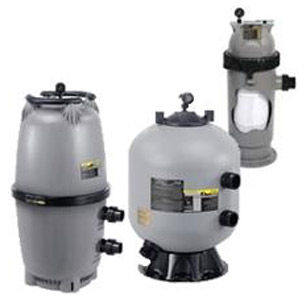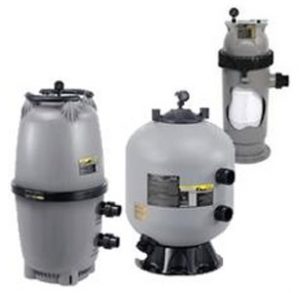What Are The Different Types Of Pool Filters Available?

There are three different types of filters that are available for use with inground pools. The three types are sand, diatomaceous earth (DE) and cartridge. Each kind has its pros and cons. The type of filter to use depends on what the pool owner wants in terms of price, amount of maintenance needed and other location based factors.
WHAT DOES A FILTER DO?

Before we discuss the specifics of the different types of filters, it is important to first discuss what a filter does and why it is so important to a pool. A filter is an item that is plumbed into the pool’s plumbing network. As the water is pushed through, it will pass through the filter the dirt and debris are trapped inside. This creates clean and filtered water. The clean water flows through an outlet pipe back into the pool. This runs in a circular fashion as long as the system is on. Depending on the type of filter and the amount of pool usage, most pool owners run the filter for a period 6 to 12 hours a day.
THE CLASSIC SAND FILTER
This is one of the oldest technologies and least expensive filter that can be purchased. If you look at most older pools unless they have been upgraded, you will find a sand filter. In a sand filter there is a tank, depending on size of the tank, there is a specific amount of sand. The sand is the media that goes into the tank. Only a special kind of sand that is specific to the pool industry can be used. The filter works by water moving through the tank from the top down. There is about 75% sand and 25% free space in the tank. As the tank fills up with water from the pool, it passes through the sand and filters out any of the microns that are large enough to be caught in the sand. This dirt and debris will remain in the tank until the entire system is backwashed. Then the filtered water will is pushed back into the pool. A sand filter normally has a multiport valve which allows anywhere from three to six functions for the filter. During normal filter operation the valve will be set on the filter mode. This is the way the filter is set most of the time. There is also a backwash mode that enables the homeowner to hook up a hose to the filter to discharge out all the dirt and debris that the sand has captured. What this basically does is reverse the flow of water through the filter from the bottom to the top; this will force all the debris that has been collected out of the filter to the discharge hose. The sand inside will generally be replaced every three to five years, depending on the length of the swim season and how well the pool is maintained. This must be done because with the water running back and forth over it, the sand particles will become much rounder which causes them to lock together. This will give a less effective filtration.
THE DE FILTER
This filter works in similar fashion to the sand filter. What is different about it is the filter media that is used. Inside of a DE filter is a set of grids or fingers as they are commonly called. These fingers are coated with a DE powder which is made of crushed sea shells and the external silica secretions of little microscopic sea creatures called diatoms. As water runs through these fingers, they trap most of the dirt and debris at a much lower micron level than a sand filter can. It can catch much smaller and finer particles, which in turn purifies the water better. This can give better water clarity and makes for a safer pool to swim in. The DE filter must also be backwashed. Unlike a sand filter, when you backwash a large amount of the DE will be washed out and lost. After backwashing you will have to add more DE powder to recharge the filter. You must be careful with DE. It is an ultra fine silicate that can cause health hazards. There is some evidence that DE can cause lung problems if breathed in, and skin irritation if not used and disposed of properly. Some even call it a carcinogen, but so far research has not proved that to be so. In New Jersey it is classified as a hazardous substance and is regulated by the Occupational Safety & Health Administration (OSHA). Certain townships require separation tanks so that the used DE is put into the tank and properly disposed of rather than being allowed to drain into the street or on the property. DE filters must be taken apart on an annual basis and the fingers have to be cleaned and degreased. They are made of a cloth mesh like material which holds onto the DE powder well. Contaminants like body oils, suntan lotion, as well as algae build up, gather on this material. Although DE filters are probably the best of the filters in clarifying the water, they do need a lot more maintenance than any of the other kinds. There is a lot more work associated with them. The DE filter is probably the second most expensive filter for a pool builder to provide, or a homeowner to purchase as an upgrade to replace an older filter. All of these are factors for you to consider when thinking about purchasing a DE filter.
THE CARTRIDGE FILTER
Cartridges filters are one of the most popular types to own. They come in multiple varieties. There are single element cartridge filters and multi element cartridge filters. The multi element types commonly contain two to four cartridges. Pool builders will usually install a pool with a multi-element filter. A premium pool builder that is trying to create the most maintenance friendly pool will normally install a four cartridge filtration system. In a cartridge filter system the cartridges trap the debris. Each can come in a variety of sizes from small, medium, to large depending on the size of the pool. They are generally made from spun polyester that is pleated and wrapped around a heavy plastic or pvc core and bound on each end with a heavy duty rubbery plastic. Water flows from outside the cartridge to the center core and the folds in the cartridge grab the dirt. It is designed to force the water through the pleats. The cartridges have a high surface area so their maintenance is greatly reduced. An inground pool that operates 12 months out of the year, the filter must be taken apart and cleaned two to three times a year. It usually takes about an hour to an hour and half to effectively clean the cartridges. This involves taking them apart and cleaning all the elements. When the cartridges are removed a hose will take off most of the heavy dirt and debris. Due to build up of body oils, suntan oils, hair products and accumulated algae, at least once a year the cartridges must degreased. If this doesn’t take place the cartridges will not give their best performance. With good maintenance a cartridge can last anywhere from four to eight years before they have to be replaced and best news replacement is easy. All you do is pull out the old ones and put new ones in. Once they are replaced it will work as if you have a brand new filter. The filter will be fully operational and at its full capacity. A cartridge filter never needs to be backwashed, does not require sand or DE media and does not require a separation tank.
WHICH TYPE OF FILTER IS RECOMMENDED?
The most common types of filters you will see are sand filters. They will effectively clean the pool for years with little or no problems. They are the most inexpensive filters to provide so are often offered as part of the basic pool package. DE filters are used less often because they are so maintenance intensive. Premium pool builders often encourage using a cartridge filter to make the pool more maintenance friendly. Most pool companies will allow you to pick and chose which filter is right for you. Sometimes the cartridge filter comes standard and other times there might be an additional charge for this. Whether this is true or not is up to the specific pool builder.
SO WHAT FILTER SHOULD I GET?
The decision on which filter to use is really dependent on the homeowners level of maintenance that they want to perform and what they think is the most important to them. Is it purification, maintenance or long-term costs? This will be different with each person. At this time there is an equal split among consumers getting DE and cartridge filters for their inground swimming pools. Sand is also very popular, but is used much more often with above ground pools due to the lower costs.
